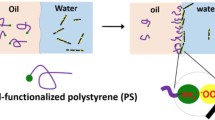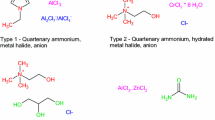Abstract
Materials are usually classified as solids or liquids, based on their structural stability, dynamic response, and rheological properties. Structured liquid, a new state of matter, has attracted much attention in recent years. Different with either solid or liquid, structured liquid combines the desirable characteristics of fluids with the structural stability of a solid, showing a myriad of potential applications in encapsulation, biphasic reactors, and programmable liquid constructs. Here, a brief review is given, by introducing a new strategy to structure liquids based on the formation, assembly, and jamming of nanoparticle surfactants (NPSs) at liquid-liquid interfaces. The interfacial packing of the NPSs can be effectively manipulated using external triggers, endowing the structured liquids with adaptiveness and responsiveness to changes in their external environment.












Similar content being viewed by others
References
Stratford K, Adhikari R, Pagonabarraga I, Desplat JC, Cates ME (2005) Colloidal jamming at interfaces: a route to fluid-bicontinuous gels. Science 309(5744):2198–2201. https://doi.org/10.1126/science.1116589
Herzig EM, White KA, Schofield AB, Poon WCK, Clegg PS (2007) Bicontinuous emulsions stabilized solely by colloidal particles. Nature Mater 6(12):966–971. https://doi.org/10.1038/nmat2055
Lee MN, Mohraz A (2010) Bicontinuous macroporous materials from bijel templates. Adv Mater 22(43):4836–4841. https://doi.org/10.1002/adma.201001696
Lee MN, Mohraz A (2011) Hierarchically porous silver monoliths from colloidal bicontinuous interfacially jammed emulsion gels. J Am Chem Soc 133(18):6945–6947. https://doi.org/10.1021/ja201650z
Lee MN, Thijssen JHJ, Witt JA, Clegg PS, Mohraz A (2013) Making a robust interfacial scaffold: bijel rheology and its link to processability. Adv Funct Mater 23(4):417–423. https://doi.org/10.1002/adfm.201201090
Hijnen N, Cai D, Clegg PS (2015) Bijels stabilized using rod-like particles. Soft Matter 11(22):4351–4355. https://doi.org/10.1039/C5SM00265F
Mohraz A (2017) Simple shaking yields bicontinuity. Nature Nanotech 12(11):1021–1022. https://doi.org/10.1038/nnano.2017.201
Shi S, Russell TP (2018) Nanoparticle assembly at liquid-liquid interfaces: from the nanoscale to mesoscale. Adv Mater 30(44):1800714. https://doi.org/10.1002/adma.201800714
Forth J, Kim PY, Xie G, Liu X, Helms BA, Russell TP (2019) Building reconfigurable devices using complex liquid-fluid interfaces. Adv Mater 31(18):e1806370. https://doi.org/10.1002/adma.201806370
Pieranski P (1980) Two-dimensional interfacial colloidal crystals. Phys Rev Lett 45(7):569–572. https://doi.org/10.1103/PhysRevLett.45.569
Dong L, Johnson D (2003) Surface tension of charge-stabilized colloidal suspensions at the water-air interface. Langmuir 19(24):10205–10209. https://doi.org/10.1021/la035128j
Bernard PB, John HC (2002) Solid wettability from surface energy components: relevance to Pickering emulsions. Langmuir 18(4):1270–1273. https://doi.org/10.1021/la011420k
Booth SG, Dryfe RAW (2015) Assembly of nanoscale objects at the liquid/liquid interface. J Phys Chem C 119(41):23295–23309. https://doi.org/10.1021/acs.jpcc.5b07733
Maestro A, Guzmán E, Ortega F, Rubio RG (2014) Contact angle of micro- and nanoparticles at fluid interfaces. Curr Opin Colloid Interface Sci 19(4):355–367. https://doi.org/10.1016/j.cocis.2014.04.008
Binks BP, Lumsdon SO (2000) Influence of particle wettability on the type and stability of surfactant-free emulsions. Langmuir 16(23):8622–8631. https://doi.org/10.1021/la000189s
Binks BP, Clint JH (2002) Solid wettability from surface energy components: relevance to Pickering emulsions. Langmuir 18(4):1270–1273. https://doi.org/10.1021/la011420k
Santini E, Guzmán E, Ravera F, Ferrari M, Liggieri L (2012) Properties and structure of interfacial layers formed by hydrophilic silica dispersions and palmitic acid. Phys Chem Chem Phys 14(2):607–615. https://doi.org/10.1039/C1CP22552A
Santini E, Guzmán E, Ferrari M, Liggieri L (2014) Emulsions stabilized by the interaction of silica nanoparticles and palmitic acid at the water–hexane interface. Colloids Surf A Physicochem Eng Aspects 460:333–341. https://doi.org/10.1016/j.colsurfa.2014.02.054
Cui M, Emrick T, Russell TP (2013) Stabilizing liquid drops in nonequilibrium shapes by the interfacial jamming of nanoparticles. Science 342(6157):460–463. https://doi.org/10.1126/science.1242852
Sun Z, Feng T, Russell TP (2013) Assembly of graphene oxide at water/oil interfaces: tessellated nanotiles. Langmuir 29(44):13407–13413. https://doi.org/10.1021/la402436w
Huang C, Sun Z, Cui M, Liu F, Helms BA, Russell TP (2016) Structured liquids with pH-triggered reconfigurability. Adv Mater 28(31):6612–6618. https://doi.org/10.1002/adma.201600691
Chai Y, Lukito A, Jiang Y, Ashby PD, Russell TP (2017) Fine-tuning nanoparticle packing at water-oil interfaces using ionic strength. Nano Lett 17(10):6453–6457. https://doi.org/10.1021/acs.nanolett.7b03462
Ngo TD, Kashani A, Imbalzano G, Nguyen KTQ, Hui D (2018) Additive manufacturing (3D printing): a review of materials, methods, applications and challenges. Compos Part B-Eng 143:172–196. https://doi.org/10.1016/j.compositesb.2018.02.012
Mead-Hunter R, King AJ, Mullins BJ (2012) Plateau Rayleigh instability simulation. Langmuir 28(17):6731–6735. https://doi.org/10.1021/la300622h
Feng T, Hoagland DA, Russell TP (2014) Assembly of acid-functionalized single-walled carbon nanotubes at oil/water interfaces. Langmuir 30(4):1072–1079. https://doi.org/10.1021/la404543s
Toor A, Helms BA, Russell TP (2017) Effect of nanoparticle surfactants on the breakup of free-falling water jets during continuous processing of reconfigurable structured liquid droplets. Nano Lett 17(5):3119–3125. https://doi.org/10.1021/acs.nanolett.7b00556
Liu X, Shi S, Li Y, Joe F, Wang D, Russell TP (2017) Liquid tubule formation and stabilization using cellulose nanocrystal surfactants. Angew Chem Int Ed 56(41):12594–12598. https://doi.org/10.1002/anie.201706839
Forth J, Liu X, Hasnain J, Toor A, Miszta K, Shi S, Geissler PL, Emrick T, Helms BA, Russell TP (2018) Reconfigurable printed liquids. Adv Mater 30(16):1707603. https://doi.org/10.1002/adma.201707603
Cain JD, Azizi A, Maleski K, Anasori B, Glazer EC, Kim PY, Gogotsi Y, Helms BA, Russell TP, Zettl A (2019) Sculpting liquids with two-dimensional materials: the assembly of Ti3C2Tx MXene sheets at liquid-liquid interfaces. ACS Nano 13(11):12385–12392. https://doi.org/10.1021/acsnano.9b05088
Naguib M, Kurtoglu M, Presser V, Lu J, Niu J, Heon M, Hultman L, Gogotsi Y, Barsoum MW (2011) Two-dimensional nanocrystals produced by exfoliation of Ti3AlC2. Adv Mater 23(37):4248–4253. https://doi.org/10.1002/adma.201102306
Naguib M, Mochalin VN, Barsoum MW, Gogotsi Y (2014) 25th anniversary article: MXenes: a new family of two-dimensional materials. Adv Mater 26(7):992–1005. https://doi.org/10.1002/adma.201304138
Liu J, Zhang HB, Sun R, Liu Y, Liu Z, Zhou A, Yu ZZ (2017) Hydrophobic, flexible, and lightweight MXene foams for high-performance electromagnetic-interference shielding. Adv Mater 29(38):1702367. https://doi.org/10.1002/adma.201702367
Bian R, Lin R, Wang G, Lu G, Zhi W, Xiang S, Wang T, Clegg PS, Cai D, Huang W (2018) 3D assembly of Ti3C2-MXene directed by water/oil interfaces. Nanoscale 10(8):3621–3625. https://doi.org/10.1039/c7nr07346a
Shi S, Liu X, Li Y, Wu X, Wang D, Forth J, Russell TP (2018) Liquid letters. Adv Mater 30(9):1705800. https://doi.org/10.1002/adma.201705800
Huang C, Forth J, Wang W, Hong K, Smith GS, Helms BA, Russell TP (2017) Bicontinuous structured liquids with sub-micrometre domains using nanoparticle surfactants. Nature Nanotech 12(11):1060–1063. https://doi.org/10.1038/nnano.2017.182
Mark D, Haeberle S, Roth G, Von Stetten F, Zengerle R (2010) Microfluidic lab-on-a-chip platforms: requirements, characteristics and applications. In: Microfluidics based microsystems. Springer, pp 305-376
Feng W, Chai Y, Forth J, Ashby PD, Russell TP, Helms BA (2019) Harnessing liquid-in-liquid printing and micropatterned substrates to fabricate 3-dimensional all-liquid fluidic devices. Nat Commun 10(1):1095. https://doi.org/10.1038/s41467-019-09042-y
Pickering SU (1907) CXCVI.—Emulsions. Journal of the Chemical Society, Transactions 91:2001–2021. https://doi.org/10.1039/CT9079102001
Ramsden W, Gotch F (1904) Separation of solids in the surface-layers of solutions and ‘suspensions’ (observations on surface-membranes, bubbles, emulsions, and mechanical coagulation).—Preliminary account. Proc R Soc London 72(477-486):156–164. https://doi.org/10.1098/rspl.1903.0034
Chevalier Y, Bolzinger M-A (2013) Emulsions stabilized with solid nanoparticles: Pickering emulsions. Colloids Surf A: Physicochemical and Engineering Aspects 439:23–34. https://doi.org/10.1016/j.colsurfa.2013.02.054
Yang Y, Fang Z, Chen X, Zhang W, Xie Y, Chen Y, Liu Z, Yuan W (2017) An overview of Pickering emulsions: solid-particle materials, classification, morphology, and applications. Front Pharmacol 8(287). https://doi.org/10.3389/fphar.2017.00287
Chen T, Colver PJ, Bon SAF (2007) Organic–inorganic hybrid hollow spheres prepared from TiO2-stabilized Pickering emulsion polymerization. Adv Mater 19(17):2286–2289. https://doi.org/10.1002/adma.200602447
Toor A, Lamb S, Helms BA, Russell TP (2018) Reconfigurable microfluidic droplets stabilized by nanoparticle surfactants. ACS Nano 12(3):2365–2372. https://doi.org/10.1021/acsnano.7b07635
Li Y, Liu X, Zhang Z, Zhao S, Tian G, Zheng J, Wang D, Shi S, Russell TP (2018) Adaptive structured Pickering emulsions and porous materials based on cellulose nanocrystal surfactants. Angew Chem Int Ed 57(41):13560–13564. https://doi.org/10.1002/anie.201808888
Shi S, Qian B, Wu X, Sun H, Wang H, Zhang HB, Yu ZZ, Russell TP (2019) Self-assembly of MXene-surfactants at liquid-liquid interfaces: from structured liquids to 3D aerogels. Angew Chem Int Ed 58(50):18171–18176. https://doi.org/10.1002/anie.201908402
Shliomis MI (1974) Magnetic fluids. Soviet Physics Uspekhi 17(2):153–169. https://doi.org/10.1070/pu1974v017n02abeh004332
Blums E, Cebers A, Maiorov MM (2010) Magnetic fluids. Walter de Gruyter
Berkovski B, Bashtovoy V (1996) Magnetic fluids and applications handbook, vol 36. Begell House, New York
Massart R, Dubois E, Cabuil V, Hasmonay E (1995) Preparation and properties of monodisperse magnetic fluids. J Magn Magn Mater 149(1-2):1–5. https://doi.org/10.1016/0304-8853(95)00316-9
Pileni MP (2001) Magnetic fluids: fabrication, magnetic properties, and organization of nanocrystals. Adv Funct Mater 11(5):323–336. https://doi.org/10.1002/1616-3028(200110)11:53.0.CO;2-J
Rosensweig RE (2013) Ferrohydrodynamics. Courier Corporation
Liu X, Kent N, Ceballos A, Streubel R, Jiang Y, Chai Y, Kim PY, Forth J, Hellman F, Shi S (2019) Reconfigurable ferromagnetic liquid droplets. Science 365(6450):264–267. https://doi.org/10.1126/science.aaw8719
Sun H, Li L, Russell TP, Shi S (2020) Photoresponsive structured liquids enabled by molecular recognition at liquid-liquid interfaces. J Am Chem Soc. 142:8591–8595. https://doi.org/10.1021/jacs.0c02555
Li R, Chai Y, Jiang Y, Ashby PD, Toor A, Russell TP (2017) Carboxylated fullerene at the oil/water interface. ACS Appl Mater Interfaces 9(39):34389–34395. https://doi.org/10.1021/acsami.7b07154
Huang C, Chai Y, Jiang Y, Forth J, Ashby PD, Arras MML, Hong K, Smith GS, Yin P, Russell TP (2018) The interfacial assembly of polyoxometalate nanoparticle surfactants. Nano Lett 18(4):2525–2529. https://doi.org/10.1021/acs.nanolett.8b00208
Gu PY, Chai Y, Hou H, Xie G, Jiang Y, Xu QF, Liu F, Ashby PD, Lu JM, Russell TP (2019) Stabilizing liquids using interfacial supramolecular polymerization. Angew Chem Int Ed 58(35):12112–12116. https://doi.org/10.1002/anie.201906339
Qian B, Shi S, Wang H, Russell TP (2020) Reconfigurable liquids stabilized by DNA surfactants. ACS Appl Mater Interfaces 12(11):13551–13557. https://doi.org/10.1021/acsami.0c01487
Xu R, Liu T, Sun H, Wang B, Shi S, Russell TP (2020) Interfacial assembly and jamming of polyelectrolyte surfactants: a simple route to print liquids in low-viscosity solution. ACS Appl Mater Interfaces 12(15):18116–18122. https://doi.org/10.1021/acsami.0c00577
Luo G, Yu Y, Yuan Y, Chen X, Liu Z, Kong T (2019) Freeform, reconfigurable embedded printing of all-aqueous 3D architectures. Adv Mater 31(49):1904631. https://doi.org/10.1002/adma.201904631
Hann SD, Lee D, Stebe KJ (2017) Tuning interfacial complexation in aqueous two phase systems with polyelectrolytes and nanoparticles for compound all water emulsion bodies (AWE-somes). Phys Chem Chem Phys 19(35):23825–23831. https://doi.org/10.1039/C7CP02809A
Hann SD, Stebe KJ, Lee D (2017) AWE-somes: all water emulsion bodies with permeable shells and selective compartments. ACS Appl Mater Interfaces 9(29):25023–25028. https://doi.org/10.1021/acsami.7b05800
Xie G, Forth J, Zhu S, Helms BA, Ashby PD, Shum HC, Russell TP (2020) Hanging droplets from liquid surfaces. Proc Natl Acad Sci USA 117(15):8360–8365. https://doi.org/10.1073/pnas.1922045117
Zhang J, Coulston RJ, Jones ST, Geng J, Scherman OA, Abell C (2012) One-step fabrication of supramolecular microcapsules from microfluidic droplets. Science 335(6069):690–694. https://doi.org/10.1126/science.1215416
Zheng Y, Yu Z, Parker RM, Wu Y, Abell C, Scherman OA (2014) Interfacial assembly of dendritic microcapsules with host-guest chemistry. Nat Commun 5:5772. https://doi.org/10.1038/ncomms6772
Patra D, Ozdemir F, Miranda O, Samanta B, Sanyal A, Rotello V (2009) Formation and size tuning of colloidal microcapsules via host-guest molecular recognition at the liquid-liquid interface. Langmuir 25:13852–13854. https://doi.org/10.1021/la9015756
Luo J, Zeng M, Peng B, Tang Y, Zhang L, Wang P, He L, Huang D, Wang L, Wang X, Chen M, Lei S, Lin P, Chen Y, Cheng Z (2018) Electrostatic-driven dynamic jamming of 2D nanoparticles at interfaces for controlled molecular diffusion. Angew Chem Int Ed 130(36):11926–11931. https://doi.org/10.1002/ange.201807372
Jiang Y, Chakroun R, Groschel AH, Russell TP (2020) Soft polymer Janus nanoparticles at liquid/liquid interfaces. Angew Chem Int Ed. 59:12751–12755. https://doi.org/10.1002/anie.202004162
Gao Y, Zhao CX, Sainsbury F (2020) Droplet shape control using microfluidics and designer biosurfactants. https://doi.org/10.26434/chemrxiv.12103284
Yang Z, Wei J, Sobolev YI, Grzybowski BA (2018) Systems of mechanized and reactive droplets powered by multi-responsive surfactants. Nature 553(7688):313–318. https://doi.org/10.1038/nature25137
Hou H, Li J, Li X, Forth J, Yin J, Jiang X, Helms BA, Russell TP (2019) Interfacial activity of amine-functionalized polyhedral oligomeric silsesquioxanes (POSS): a simple strategy to structure liquids. Angew Chem Int Ed 131(30):10248–10253. https://doi.org/10.1002/anie.201903420
Funding
T.P.R. was supported by the US Department of Energy, Office of Science, Office of Basic Energy Sciences, Materials Sciences and Engineering Division under Contract No. DE-AC02-05-CH11231 within the Adaptive Inter-facial Assemblies Towards Structuring Liquids program (KCTR16). This work was supported by the Beijing Natural Science Foundation (2194083) and National Natural Science Foundation of China (51903011).
Author information
Authors and Affiliations
Corresponding authors
Ethics declarations
Conflict of interest
The authors declare that they have no conflict of interest
Additional information
Publisher’s note
Springer Nature remains neutral with regard to jurisdictional claims in published maps and institutional affiliations.
Rights and permissions
About this article
Cite this article
Sun, S., Liu, T., Shi, S. et al. Nanoparticle surfactants and structured liquids. Colloid Polym Sci 299, 523–536 (2021). https://doi.org/10.1007/s00396-020-04724-2
Received:
Revised:
Accepted:
Published:
Issue Date:
DOI: https://doi.org/10.1007/s00396-020-04724-2




